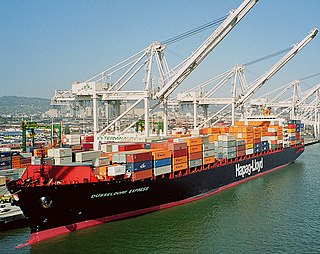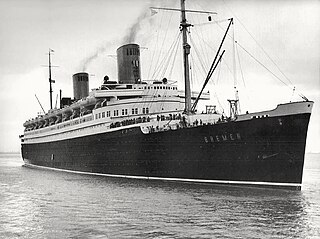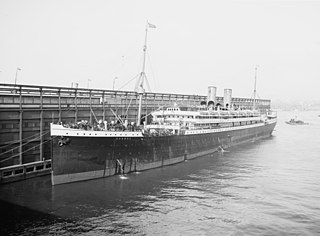Bremen is a city in northwestern Germany.
Contents
- Places
- Germany
- United States
- Elsewhere
- Arts and entertainment
- People
- Transportation and military
- German Navy ships
- Passenger ships
- Aviation
- Other uses
- See also
Bremen may also refer to:
Bremen is a city in northwestern Germany.
Bremen may also refer to:

Kaiser Wilhelm der Grosse was a German transatlantic ocean liner in service from 1897 to 1914, when it was scuttled in battle. It was the largest ship in the world for a time, and held the Blue Riband until Cunard Line’s Lusitania entered service in 1907. The vessel’s career was relatively uneventful, despite a refit in 1913.
Lafayette or La Fayette may refer to:

Aktien-Gesellschaft „Weser" was one of the major German shipbuilding companies, located at the Weser River in Bremen. Founded in 1872 it was finally closed in 1983. All together, A.G. „Weser" built about 1,400 ships of different types, including many warships. A.G. „Weser" was the leading company in the Deutsche Schiff- und Maschinenbau AG, a cooperation of eight German shipbuilding companies between 1926 and 1945.
Gneisenau may refer to:

Hapag-Lloyd AG is a German international shipping and container transportation company. It was formed in 1970 through a merger of Hamburg-American Line (HAPAG) and Norddeutscher Lloyd.

An ocean liner is a type of passenger ship primarily used for transportation across seas or oceans. Ocean liners may also carry cargo or mail, and may sometimes be used for other purposes. Only one ocean liner remains in service today.
Hamburg, officially the Free and Hanseatic City of Hamburg, is Germany's second-largest city and a federated state.

SS Bremen was a German-built ocean liner constructed for the Norddeutscher Lloyd line (NDL) to work the transatlantic sea route. Bremen was notable for her bulbous bow construction, high-speed engines, and low, streamlined profile. At the time of her construction, she and her sister ship Europa were the two most advanced high-speed steam turbine ocean liners of their day. The German pair sparked an international competition in the building of large, fast, luxurious ocean liners that were national symbols and points of prestige during the pre-war years of the 1930s. She held the Blue Riband, and was the fourth ship of NDL to carry the name Bremen.

USS Susquehanna (ID-3016) was a transport for the United States Navy during World War I. She was the second U.S. Navy ship to be named for the Susquehanna River. Before the war she operated at SS Rhein, an ocean liner for North German Lloyd. She was the lead ship of her class of three ocean liners. After the end of World War I, the ship operated briefly in passenger service as SS Susquehanna. Laid up in 1922, Susquehanna was sold to Japanese ship breakers in 1928 and scrapped.

The Hamburg-Amerikanische Packetfahrt-Aktien-Gesellschaft (HAPAG), known in English as the Hamburg America Line, was a transatlantic shipping enterprise established in Hamburg, in 1847. Among those involved in its development were prominent citizens such as Albert Ballin, Adolph Godeffroy, Ferdinand Laeisz, Carl Woermann, August Bolten, and others, and its main financial backers were Berenberg Bank and H. J. Merck & Co. It soon developed into the largest German, and at times the world's largest, shipping company, serving the market created by German immigration to the United States and later, immigration from Eastern Europe. On 1 September 1970, after 123 years of independent existence, HAPAG merged with the Bremen-based North German Lloyd to form Hapag-Lloyd AG.
Norddeutscher Lloyd was a German shipping company. It was founded by Hermann Henrich Meier and Eduard Crüsemann in Bremen on 20 February 1857. It developed into one of the most important German shipping companies of the late 19th and early 20th centuries, and was instrumental in the economic development of Bremen and Bremerhaven. On 1 September 1970, the company merged with Hamburg America Line (HAPAG) to form Hapag-Lloyd AG.

Deutsche Schiff- und Maschinenbau Aktiengesellschaft was a cooperation of eight German shipyards in the period 1926 to 1945. The leading company was the shipyard AG Weser in Bremen.

SS George Washington was an ocean liner built in 1908 for the Bremen-based North German Lloyd and was named after George Washington, the first President of the United States. The ship was also known as USS George Washington (ID-3018) and USAT George Washington in service of the United States Navy and United States Army, respectively, during World War I. In the interwar period, she reverted to her original name of SS George Washington. During World War II, the ship was known as both USAT George Washington and, briefly, as USS Catlin (AP-19), in a short, second stint in the U.S. Navy.

The SS Bremen, later renamed Constantinople and then King Alexander, was a German Barbarossa class ocean liner commissioned in 1897 by Norddeutscher Lloyd.

SS Scharnhorst was a Norddeutscher Lloyd ocean liner, launched in 1934, completed in 1935 and made her maiden voyage on 8 May 1935. She was the first big passenger liner built by the Third Reich. Under the German merchant flag, she was the second liner named after General Gerhard J. D. von Scharnhorst. She was one of three ships on the Far Eastern route between Bremen and Yokohama; her sister ships were Potsdam and Gneisenau. These three ships were planned to shorten the journey time between Bremen and Shanghai from the usual 50 days to 34. She was trapped in Japan in September 1939 and later converted into an Imperial Japanese Navy aircraft carrier named Shin'yō in 1942 and sunk by the US submarine USS Spadefish in 1944.

The SS König Albert was a German Barbarossa class ocean liner owned by the Norddeutscher Lloyd Line. Interned in Italy at the outbreak of World War I, she was seized by the Italian Government in 1915 and converted to a hospital ship. Sold into merchant service in 1920, she was used as a transport for the Italian Navy, before being scrapped in 1926.

SS Prinz Friedrich Wilhelm was an ocean liner for North German Lloyd (NDL) from her launch in 1907 until the end of World War I. After the war, she briefly served as USS Prinz Friedrich Wilhelm (ID-4063) for the United States Navy returning American troops from France. The vessel was first chartered—and later purchased outright—by Canadian Pacific Steamships (CP) and operated under the names Empress of China, Empress of India, Montlaurier, Monteith, and Montnairn. She was scrapped in 1929.

The Kaiser-class ocean liners or Kaiserklasse refer to four transatlantic ocean liners of the Norddeutscher Lloyd, a German shipping company. Built by the AG Vulcan Stettin between 1897 and 1907, these ships were designed to be among the largest and best appointed liners of their day. These four ships, two of which held the prestigious Blue Riband, were known as the "four flyers" and all proved to be popular with wealthy transatlantic travellers. They also took great advantage of the masses of emigrants who wished to leave Europe.

SS Albertic was a British ocean liner, originally built as the Norddeutscher Lloyd's München. It was handed to Britain as part of war reparations and served during the 1920s and 1930s.
SS Berlin may refer to one of the following ships